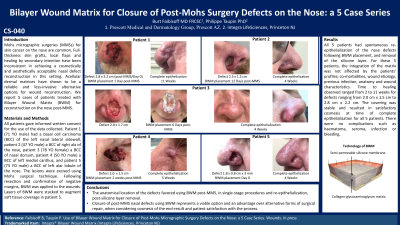Back

Case Series/Study
(CS-040) Bilayer Wound Matrix for Closure of Post-Mohs Surgery Defects on the Nose: a 5 Case Series

Co-Author(s):
Philippe Taupin, PhD
<b>Introduction</b>: <p class="MsoNormal" style="margin-bottom: 0in; line-height: normal;"><span style="font-size: 12.0pt; font-family: 'Times New Roman',serif;">Mohs micrographic surgeries (MMSs) for skin cancer on the nose are common. Full-thickness skin grafts, local flaps and healing by secondary intention have been inconsistent in achieving a cosmetically and aesthetically acceptable nasal defect reconstruction in this setting. Acellular dermal matrices have shown to be a reliable and less-invasive alternative options for wound reconstruction. We report 5 cases of patients treated with Bilayer Wound Matrix (BWM) for reconstruction on the nose post-MMS.</span></p><br/><br/><b>Methods</b>: <p class="MsoNormal" style="margin-bottom: 0in; line-height: normal;"><span style="font-size: 12.0pt; font-family: 'Times New Roman',serif;">Patient 1 (71 YO male) had a basal cell carcinoma (BCC) of the left nasal lateral sidewall, patient 2 (47 YO male) a BCC of right ala of the nose, patient 3 (78 YO female) a BCC of nasal dorsum, patient 4 (50 YO male) a BCC of left medial canthus, and patient 5 (73 YO male) a BCC of left alar lobule of the nose. The lesions were excised using Mohs surgical technique. Following resection and confirmation of negative margins, BWM was applied to the wounds. Layers of BWM were stacked to augment soft tissue coverage in patient 5.</span></p><br/><br/><b>Results</b>: <strong><strong></strong></strong>
<p class="MsoNormal" style="margin-bottom: 0in; line-height: normal;"><span style="font-size: 12.0pt; font-family: 'Times New Roman',serif;">All 5 patients had spontaneous re-epithelialization of the nose defects following BWM placement, and removal of the silicone layer. For these 5 patients, the integration of the matrix was not affected by the patients’ profiles; co-morbidities, wound etiology, previous infection, anatomy and wound characteristics. Time to healing observed ranged from 2 to 11 weeks for defects ranging from 2.0 cm x 1.5 cm to 2.8 cm x 2.2 cm. The covering was stable and resulted in satisfactory cosmesis at time of complete epithelialization for all 5 patients.</span> <span style="font-size: 12.0pt; font-family: 'Times New Roman',serif;">There were no complications such as haematoma, seroma, infection or bleeding.</span></p><br/><br/><b>Discussion</b>: <strong><strong></strong></strong>
<p class="MsoNormal" style="margin-bottom: 0in; line-height: normal;"><span style="font-size: 12.0pt; font-family: 'Times New Roman',serif;">The anatomical location of the defects favored using BWM post-MMS, in single-stage procedures and re-epithelialization, post-silicone layer removal. Closure of post-MMS nasal defects using BWM represents a viable option and an advantage over alternative forms of surgical repair, when considering cosmesis of the end-result and patient satisfaction with the process.</span></p><br/><br/><b>Trademarked Items</b>: Integra® Bilayer Wound Matrix<br/><br/><b>References</b>: <br/><br/>
<p class="MsoNormal" style="margin-bottom: 0in; line-height: normal;"><span style="font-size: 12.0pt; font-family: 'Times New Roman',serif;">All 5 patients had spontaneous re-epithelialization of the nose defects following BWM placement, and removal of the silicone layer. For these 5 patients, the integration of the matrix was not affected by the patients’ profiles; co-morbidities, wound etiology, previous infection, anatomy and wound characteristics. Time to healing observed ranged from 2 to 11 weeks for defects ranging from 2.0 cm x 1.5 cm to 2.8 cm x 2.2 cm. The covering was stable and resulted in satisfactory cosmesis at time of complete epithelialization for all 5 patients.</span> <span style="font-size: 12.0pt; font-family: 'Times New Roman',serif;">There were no complications such as haematoma, seroma, infection or bleeding.</span></p><br/><br/><b>Discussion</b>: <strong><strong></strong></strong>
<p class="MsoNormal" style="margin-bottom: 0in; line-height: normal;"><span style="font-size: 12.0pt; font-family: 'Times New Roman',serif;">The anatomical location of the defects favored using BWM post-MMS, in single-stage procedures and re-epithelialization, post-silicone layer removal. Closure of post-MMS nasal defects using BWM represents a viable option and an advantage over alternative forms of surgical repair, when considering cosmesis of the end-result and patient satisfaction with the process.</span></p><br/><br/><b>Trademarked Items</b>: Integra® Bilayer Wound Matrix<br/><br/><b>References</b>: <br/><br/>

.png)